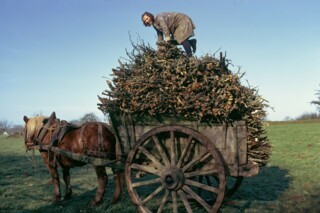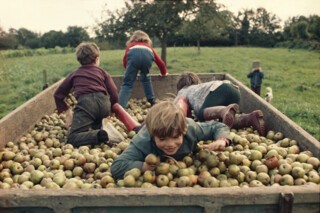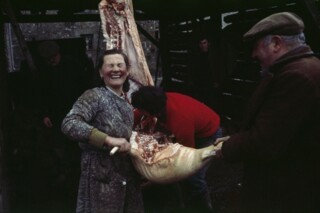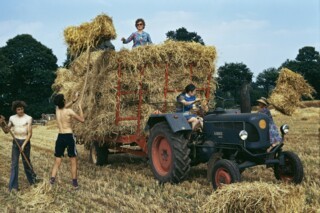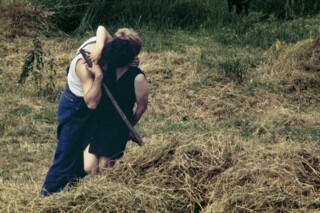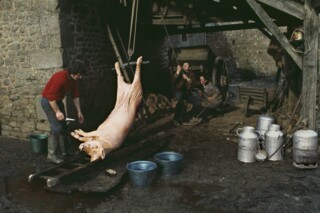The commune of Poilley in Brittany is fifteen minutes by car from the coast, but in Madeleine de Sinéty’s photographs we imagine a village miles from a beach or a harbour and further still from Rennes, the regional capital. Sinéty discovered Poilley by chance in the early 1970s. She had been on holiday, and heading to Paris, where she worked as a magazine illustrator – for Marie-Claire, among others. She took the backroads to avoid the traffic and stopped for the night in an obscure village. The following morning, she got her bike down from the car and toured the neighbourhood. She was eyed with suspicion by a five-year-old girl walking with her grandmother, who later befriended Sinéty and became godmother to her son. By then Sinéty was spending most of her time in Poilley, building a photographic record of its inhabitants, their animals (dead or alive), and the routines (daily or seasonal) that structured village life. In the early 1980s she left for the US and the project came to an end. She died some years later, leaving more than thirty thousand colour transparencies and twenty thousand black and white negatives of scenes shot in and around the village.
There are roughly ninety prints in Un Village (GwinZegal, €30), almost all of them from transparencies: a tiny fragment of Sinéty’s archive. With her now-or-never haste and her ill-lit parlours, barns and school corridors, she is a model of the self-taught photographer. But when Sinéty fetched up in Poilley, she had already studied painting and drawing at the elite Arts Deco in Paris. She had recently got hold of a Nikon single lens reflex camera and was keeping copious notes on the results of her early forays into photography.
There’s no doubting her love for the residents of Poilley, or their confidence in her. Only one photograph – a portrait of a group at a table strewn with bottles and breadcrumbs – gives any hint of reticence on the part of her subjects. Whether they look directly at the camera or go about their business, the people of Poilley have made social and psychological room for this photographer going about hers. In several they have her under gentle scrutiny. A portrait of a young girl, arms folded on a table covered with a striped oilcloth, is reminiscent of the young boy at the centre of a group portrait of three ‘Breton children’ by the British artist Eric Forbes-Robertson, done in the 1890s (and now in Leicester). In the painting, the boy looks to his left, away from the artist, and his hands clutch a soup bowl. In the photograph, Sinéty’s subject gazes straight at the camera. The violent ruddiness of the boy’s cheeks is a discreet but discernible flush in hers. The opacity and inwardness of the boy has given way, in Sinéty’s young girl, to a curiosity about the process of sitting – she’s neither posed nor wholly unselfconscious – and about Sinéty’s own interest in their encounter. Behind the girl the TV is switched off. The screen reflects the light from the windows at the photographer’s back.
In another shot, a man is preparing a cow for butchering. A young boy in a cloth cap and red gumboots takes up a confident posture as ambassador for his family’s way of life, standing just to the right of the pale, divested carcass, and gazes in Sinéty’s direction. By looking straight at her, both he and the girl with her arms folded seem to be asking for a fair account of village life that does justice to the busy adults who took Sinéty on trust as she built a pictorial record of haymaking, pig-slaughtering, grave-digging, apple harvests, festivals, dances, brides on their wedding day, nuns teaching arithmetic at the blackboard or doing the dishes with the children after school dinners.
The prints in Un Village suggest that Sinéty was eager to be part of the network of social relations she discovered in Poilley, the manners and protocols of village life, its rhythms of labour and repose. In the end, this wish to be fully subsumed into her material made her an insider, but only a few of her portraits, most of them shot indoors, propose the illusion of intimacy. For the children, swimming in a stream or rolling in a cart full of apples, leisure activities are often the result of a fleeting opportunity, hurriedly seized. For the adults they’re a more formal affair, with feasts and dances dictated by the calendar or a seasonal change in the patterns of work. Out in the meadows or in the barns, Sinéty is deeply engaged with labour and livelihood, allowing work itself to take centre stage, even though she has a sharp eye for distinctions among the labourers. In one shot of haymaking, a young man in shorts and another in flared jeans load bales onto a trailer hitched to a state-of-the art tractor while a woman in a patterned dress and sunglasses sets them in order. In the next shot, two older women and a man are heaving tedded hay onto their cart with pitchforks; their tractor is a crock.
Sinéty kept a diary of her early days in Poilley. It’s here that her figures in a managed landscape emerge as people. She was in her late thirties and came from a wealthy background. She knew about tenant farming: her great-grandmother owned a château and plenty of land in the Loire Valley. In one entry she tells the story of the Denoual family in Poilley, recently moved to a new part of their landlord’s property. Not the least of their objections is that they’ve had to rip up the hedgerows dividing their new land to make it viable. The landlord brings in ‘free’ bulldozers to dig out the stumps, but the family soon discovers it’s saddled with a debt for the loan of machinery, payable over twenty years.
In January 1975, Sinéty is helping Mme Denoual collect the valuable remains of the hedgerows that Denoual père has already sorted and bundled. A mountain of wood towers above the sideboards of the cart; Mme Denoual takes the reins and their mare begins the long haul back to the homestead. Sinéty records that she and M. Denoual return down a tarmac road on foot – ‘or rather, in clogs’, which she is still learning to master. As one foot goes forward and the clog falls, a clack in the wintry air announces that the loose clog on her other foot is about to drop and fasten her to the road: she is learning a step at a time. Later, at lunch, M. Denoual reads the local paper and his daughter takes Sinéty down to the cellar, armed with a jug, where they suck on a rubber tube at the head of a barrel until the cider flows. Among Sinéty’s best shots are one of a woman crouching on a cartload of wood as a mare stands patiently between the shafts, and another of a man in a beret in a sombre interior reading a broadsheet newspaper.
It’s a pity we don’t have more of Sinéty’s journal. The excerpts in Un Village begin in the summer of 1974 after the elections that took Valéry Giscard d’Estaing to the Elysée and end two years later with Sinéty feeling her child adjust its position in her belly as she watches a pear tree lit by a veiled moon. She imagines a trembling newborn calf in a nearby meadow and decides that her time in Poilley might be up. She left the village a few years later to join her husband in the US, but in this journal entry, she is already weighing up the idea of separateness: the cow and her calf, herself and her child to be, her work and its object.
In 1974, Sinéty’s acquaintances in Poilley were happy about Mitterrand’s defeat in the presidential elections. ‘He used to wear spectacles,’ one of them tells her. ‘Then he took them off once he wanted to run for the presidency. Did he see any better? … He would look up, or to left and right, but he never looked you in the eye.’ Five years earlier, the voters of Brittany had rallied to Georges Pompidou, de Gaulle’s successor. In 1981, they voted for Giscard d’Estaing, as they had in 1974, although the margin was narrower and Mitterrand won the presidency. In 1988, they were solid for Mitterrand and in 2012 for François Hollande. Since 2017, in the absence of a centre-left party, they have opted for Emmanuel Macron and La République en Marche. In the parliamentary elections last month, they voted overwhelmingly for the president’s alliance, Ensemble, with Jean-Luc Mélenchon’s left-green alternative trailing in second place. Marine Le Pen’s Rassemblement National, which pulled off an astonishing success at national level – 89 seats compared to eight in 2017 – was eliminated in Ille-et-Vilaine after round one. It did no better in the region as a whole, with Macron’s alliance taking sixteen seats to Mélenchon’s six.
Macron’s pro-European inclination is shared by a majority of Bretons, even if French voters elsewhere were less convinced. Brittany was in favour of the European constitution in 2005, when it was rejected by most of France’s voters. But even in Sinéty’s day, it was clear that tenant farmers in places like Poilley might not be long-term beneficiaries of the Common Agricultural Policy, drawn up by the EEC in the early 1960s. Half a century later large-scale farming is entrenched: dairy, poultry, pork, feed cereals and vegetables. (Brittany is the biggest producer of pigs in France and its market-garden sector is one of the largest in the country.) But intensive farming has raised concerns about ammonia in the atmosphere and pesticides in the groundwater, loss of hedgerows and natural woodland, periodic sickness in herds and flocks, and for smallholders, like Sinéty’s subjects, mixed, low-footprint farming is still precarious. For the latest iteration of the CAP, which comes into force next year, EU member states were allowed to submit plans on how to disburse the allocation in their own countries. Breton farmers would like to go one step further, to take responsibility for local disbursements away from Paris and decide for themselves. A delicate alliance of people working on the land, including agribusinesses that want to clean up their image and eventually their practices, are in favour. It’s a long shot, but Brussels has already chided the French government for its lack of ambition on ‘ecological’ and ‘climate’ targets in its agriculture sector.
Both younger Bretons and recent arrivals in the region, where labour is in demand, are plagued by housing shortages. Tens of thousands of second homes, not all overlooking the splendid seafronts, are empty for most of the year. The latest idea is a ‘statut de résident’ that would debar anyone who has lived in Brittany for less than a year from acquiring property. Madeleine de Sinéty never bought a place in Poilley, despite her attachment to the village, but continued to rent the postmaster’s old apartment during her absence in the US. She returned in 1990 to find all her belongings intact. She gave up her tenancy in the late 1990s and took her last photos in Poilley in 2001.
Nowadays, poverty in Brittany afflicts young people in the larger towns and the elderly in rural areas. In Sinéty’s time the family was still the indivisible unit of wealth generation in many Breton smallholdings. Her photographs rarely insist on the hardship of her poorer subjects, but she’s aware of the per diem costs of running a household. Anyone who wants to splash out on a new frock has first to take a long look at the accounts and a deep breath. In a diary entry for 1975, Sinéty records that one of the villagers, Anna Touchard, has bought a pair of leather shoes for 8000 ‘old francs’. Sinéty breaks down the cost in terms of the Touchards’ potato crop: roughly 200 kilograms of potatoes, or 24 hours’ work – an underestimate, for sure – on 150 square metres of land, plus the outlay for plants and fertiliser. Today, on the minimum wage, you can buy a decent pair of trainers with a day’s earnings – a bargain by comparison, and, if you’re walking back from lunch, or loading brushwood, quieter than clogs.
Send Letters To:
The Editor
London Review of Books,
28 Little Russell Street
London, WC1A 2HN
letters@lrb.co.uk
Please include name, address, and a telephone number.

